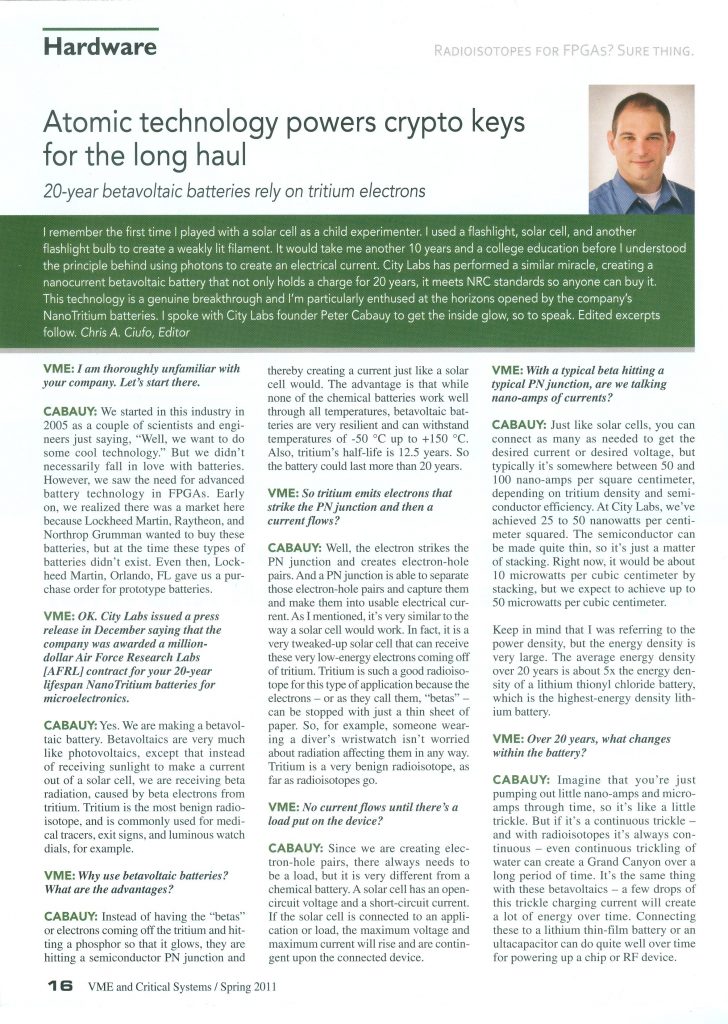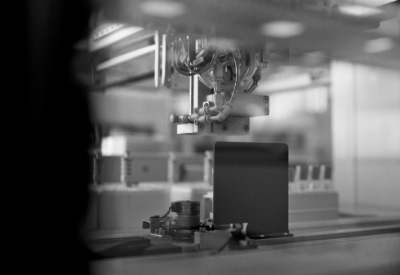Atomic technology powers crypto keys for the long haul — 20-year betavoltaic batteries rely on tritium electrons

I remember the first time I played with a solar cell as a child experimenter. I used a flashlight, solar cell, and another flashlight bulb to create a weakly lit filament. It would take me another 10 years and a college education before I understood the principle behind using photons to create an electrical current. City Labs has performed a similar miracle, creating a nanocurrent betavoltaic battery that not only holds a charge for 20 years, it meets nuclear regulatory guidelines so anyone can buy it.
This technology is a genuine breakthrough and I’m particularly enthused at the horizons opened by the company’s NanoTritium batteries. I spoke with City Labs founder Peter Cabauy to get the inside glow, so to speak. Edited excerpts follow.
— Chris A. Ciufo, Editor
CABAUY: We started in this industry in 2005 as a couple of scientists and engineers just saying, “Well, we want to do some cool technology.” But we didn’t necessarily fall in love with batteries. However, we saw the need for advanced battery technology in FPGAs. Early on, we realized there was a market here because Lockheed Martin, Raytheon, and Northrop Grumman wanted to buy these batteries, but at the time these types of batteries didn’t exist. Even then, Lockheed Martin, Orlando, FL gave us a purchase order for prototype batteries.
VME: OK. City Labs issued a press release in December saying that the company was awarded a million-dollar Air Force Research Labs [AFRL] contract for your 20-year lifespan NanoTritium batteries for microelectronics.
CABAUY: Yes. We are making a betavoltaic battery. Betavoltaics are very much like photovoltaics, except that instead of receiving sunlight to make a current out of a solar cell, we are receiving beta radiation, caused by beta electrons from tritium. Tritium is the most benign radioisotope, and is commonly used for medical tracers, exit signs, and luminous watch dials, for example.
VME: Why use betavoltaic batteries? What are the advantages?
CABAUY: Instead of having the “betas” or electrons coming off the tritium and hitting a phosphor so that it glows, they are hitting a semiconductor PN junction and thereby creating a current just like a solar cell would. The advantage is that while none of the chemical batteries work well through all temperatures, betavoltaic batteries are very resilient and can withstand temperatures of -50 °C up to +150 °C. Also, tritium’s half-life is 12.5 years. So the battery could last more than 20 years.
VME: So tritium emits electrons that strike the PN junction and then a current flows?
CABAUY: Well, the electron strikes the PN junction and creates electron-hole pairs. And a PN junction is able to separate those electron-hole pairs and capture them and make them into usable electrical current. As I mentioned, it’s very similar to the way a solar cell would work. In fact, it is a very tweaked-up solar cell that can receive these very low-energy electrons coming off of tritium. Tritium is such a good radioisotope for this type of application because the electrons – or as they call them, “betas” – can be stopped with just a thin sheet of paper. So, for example, someone wearing a diver’s wristwatch isn’t worried about radiation affecting them in any way. Tritium is a very benign radioisotope, as far as radioisotopes go.
VME: No current flows until there’s a load put on the device?
CABAUY: Since we are creating electron-hole pairs, there always needs to be a load, but it is very different from a chemical battery. A solar cell has an open-circuit voltage and a short-circuit current. If the solar cell is connected to an application or load, the maximum voltage and maximum current will rise and are contingent upon the connected device.
VME: With a typical beta hitting a typical PN junction, are we talking nano-amps of currents?
CABAUY: Just like solar cells, you can connect as many as needed to get the desired current or desired voltage, but typically it’s somewhere between 50 and 100 nano-amps per square centimeter, depending on tritium density and semiconductor efficiency. At City Labs, we’ve achieved 25 to 50 nanowatts per centimeter squared. The semiconductor can be made quite thin, so it’s just a matter of stacking. Right now, it would be about 10 microwatts per cubic centimeter by stacking, but we expect to achieve up to 50 microwatts per cubic centimeter.
Keep in mind that I was referring to the power density, but the energy density is very large. The average energy density over 20 years is about 5x the energy density of a lithium thionyl chloride battery, which is the highest-energy density lithium battery.
VME: Over 20 years, what changes within the battery?
CABAUY: Imagine that you’re just pumping out little nano-amps and micro-amps through time, so it’s like a little trickle. But if it’s a continuous trickle – and with radioisotopes it’s always continuous – even continuous trickling of water can create a Grand Canyon over a long period of time. It’s the same thing with these betavoltaics – a few drops of this trickle charging current will create a lot of energy over time. Connecting these to a lithium thin-film battery or an ultacapacitor can do quite well over time for powering up a chip or RF device.
VME: Is that the typical system configuration: One of these betavoltaics connected to a lithium ion battery to power the circuitry?
CABAUY: That’s one configuration. The central application we’ve been looking at is to take the betavoltaic battery and use it to power up FPGA encryption keys held in SRAM – at any temperature. Nano-amps is typically sufficient and it can easily be provided by the NanoTritium battery. Furthermore, the NanoTritium battery can reliably withstand extreme temperature conditions.
Battery-backed SRAM power is extremely important in fielded military applications such as a UAV, when it’s flying about 30-40,000 feet at -60 ˚C, then comes back down and lands in a very hot desert. Chemical batteries can see failure pretty quickly in a case like that. And when you’re dealing with encryption keys, failure is not something you want to happen lest the system go brain dead upon power failure.
VME: Do you have an off-the-shelf version in existence yet?
CABAUY: We’re finalizing the design components and assemblies for the EOL200Y20 series, which is the FPGA encryption key battery and the first COTS betavoltaic battery. We’re projecting a summer release.
And I’d like to point out that the betavoltaic battery is nothing new. This idea has been around since Paul Rappaport, one of the fathers of solar cells, did his groundbreaking solar cell development [in the 1950s].
VME: It sounds like these advancements have been a long time coming.
CABAUY: Yes. It took decades of research and work for people to figure out the most viable candidates for radioisotopes: tritium, promethium, and Nickel 63.
Promethium is interesting; only has a half-life of 2.6 years, and it’s very difficult to get these days. Promethium 147 requires a bit of metal to be able to shield out the radiation coming out of it.
On the other hand, nickel is expensive and the flux is very, very low, so the usable power that comes out of it is not as good. Of the three, tritium is the preferred choice to generate betas.
VME: Let’s talk about the coming COTS betavoltaic battery you mentioned earlier, the EOL200Y20 Series. “EOL” can have a negative connotation in the defense industry.
CABAUY: It actually does stand for “end-of-life,” yes, but what we’re basically saying is that at end-of-life, it will have 200 nanowatts at year 20. That’s why our NanoTritium betavoltaic battery is called “EOL200Y20.”
VME: What are the negatives of this technology? Does it outgas? Does it tend to be explosive?
CABAUY: I think the only negative is that it’s taken this long to commercialize a betavoltaic battery. As I mentioned, this idea came out in the 1950s and it seems like it’s only now at the point of usability, mostly because the FPGA and microelectronics industries have lowered their power requirements to start using long-term power like this.
VME: Which other applications do you foresee for betavoltaic batteries?
CABAUY: Within the defense industry, we see specifics with security supervisors, low-power microcontrollers like the MSP430 from Texas Instruments, or even ubiquitous computing. For instance, they’re usable for these very low-power microprocessors that can sleep on picowatts and operate at nanowatts.
Also, these batteries could power the University of Michigan’s Phoenix Processor, a very low-power device implanted transdermally to detect whether a tumor is regrowing. Or for a glaucoma patient, they put sensors and processors inside the eye. NanoTritium battery technology, which can be made as thin and small as a cubic millimeter, can be combined with a battery chip sensor that can then be implanted into all sorts of medical applications that no one’s even thought about.
VME: Any other possible applications before we move on?
CABAUY: There are also applications within Homeland Security, intelligence sensors, structural integrity sensors, sensor actuators, space satellite pro-power sources, and crystal oscillators, if they’re within 15 microwatts. Combine these batteries with a lithium thin-film battery, some type of lithium ion battery, or an ultracapacitor, and that can keep these batteries topped off for years until a usage need arises. So the battery’s self-discharge is eliminated and then it can be used like a reserve battery. Or it can be used in combination with duty-cycle and it can operate and provide a power burst every week, every day, for RF signals and so forth. The applications are unlimited.
VME: As we wrap up, is there anything else we should know about City Labs or tritium-based batteries?
CABAUY: Yes. Since the NanoTritium batteries are radioisotope powered, you can’t just go buy them at the corner market. Typically, their use requires radiation training and a radioactive license on behalf of the user or the individual purchasing them.
VME: What does this mean? That the user needs to be a nuclear engineer?
CABAUY: Normally, radioisotope products are classified under three general headings: specific license, general license, or exempt license. The smoke alarm you see in your home or office is an exempt license. The Exit sign you see at Home Depot or in a commercial aircraft is illuminated with tritium, also falling under a general license. And, medical tracers and the things the Department of Energy is using – those are under the specific license.
Very few products obtain the general license or exempt license status, because they have to be proven inherently safe through all sorts of testing processes. But City Labs recently achieved regulatory approval in the form of a general license issued by the Florida Department of Health – Bureau of Radiation Control; as an Agreement State, Florida’s general license mirrors the policies and guidelines established by the Nuclear Regulatory Commission. So now we can sell our NanoTritium batteries anywhere in the United States. You can just put the order in and receive it without any training, without any prior radiation license. There’s never been a general license classification for a battery before, so that says that we broke some ground in the industry. CS
Peter Cabauy cofounded City Labs, Inc. in 2005 and serves as CEO. Peter received his Ph.D. from the University of Michigan in Applied Physics and a BS from Florida International University. Contact him at pcabauy@citylabs.net.









